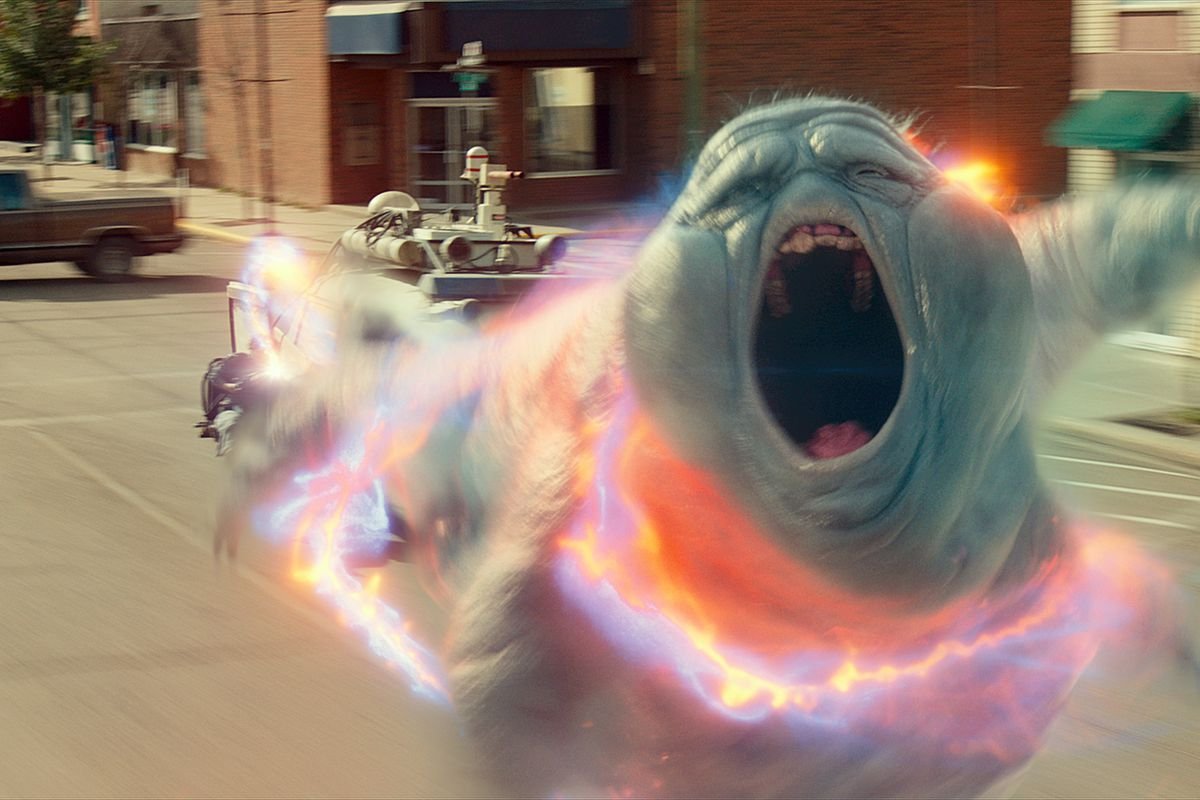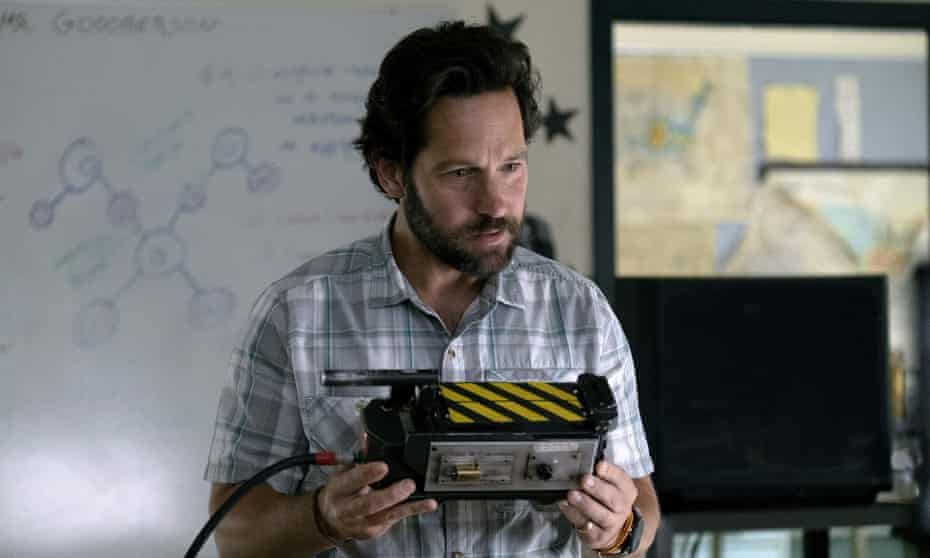‘Ghostbusters: Afterlife’ Review: A Mostly Enjoyable Exercise in Nostalgia
While the callbacks to the original film don’t really work, ‘Ghostbusters: Afterlife’ still manages to be a good time thanks to its lead performances from Mckenna Grace, Finn Wolfhard and Paul Rudd.
“Ghostbusters: Afterlife” feels more like a “Goonies” sequel than a “Ghostbusters” one during its first hour and a half. And that’s when the movie truly shines. When it tries to reference past “Ghostbusters” instalments for the sake of nostalgia, the movie quickly sinks into near-disaster territory with egregious (and unnecessary) cameos, throwback lines, and moments designed to make an audience member point at the screen like the famous line from Family Guy and say, “He said it! He said the thing!” It didn’t work in Paul Feig’s 2016 reboot, and it sure as hell doesn’t work here.
At least we’ve got the original cast returning to play their respective roles, instead of them being terribly uncomfortable (and uninterested) in doing extended cameos of random characters just for them to cash in on the reboot. Feig’s movie wasn’t necessarily a bad one, but its unconfidence in veering off the original cast stained it before it was even released. Now Jason Reitman is finally giving audiences the “Ghostbusters 3” they’ve always wanted, but it feels more like a re-hash of Ivan Reitman’s original film than anything else.
Of course, stepping into his father’s shoes isn’t an easy task, but Jason seems so desperate to impress his dad instead of making his own version of “Ghostbusters”. The references begin right at the beginning as Rob Simonsen’s music oddly resembles Elmer Bernstein’s piano-driven score from the first film, as we meet the Spengler family who relocates to Summerville after they are evicted from their apartment and learn that Egon (Harold Ramis) has died. The mother, Callie (Carrie Coon), believes Egon has left something for them in Summerville, but when they arrive, the house is in a decrepit state and is ridden in debt.
In the house, the daughter, Phoebe (Mckenna Grace) starts to get weirded out by Egon’s house as she senses a supernatural presence lurking inside. But she quickly finds out that his grandfather was a Ghostbuster and had a plan to keep Summerville’s ancient secret at bay. After accidentally freeing a ghost with her friend Podcast (Logan Kim) and her teacher Mr. Grooberson (Paul Rudd), Summerville starts to experience strange phenomena and becomes the new host town for Gozer the Gozerian, poised to make their grand return...unless Phoebe, her brother Trevor (Finn Wolfhard) stop them through Egon’s plan.
Gozer the Gozerian means Zuul, so there’s obviously going to be the “There is no [insert name], only Zuul” line peppered into the mix. But the references to the original “Ghostbusters” don’t stop there. The most eye-rolling one is when Phoebe, locked up in jail with her brother and Podcast, requests her phone call from Bokeem Woodbine’s Sheriff Domingo, who then looks at her and says “Who you gonna call?”
This entire line sums up Reitman’s nostalgia-driven project, and it starts to border on offensive territory once Peter Venkman (Bill Murray), Ray Stantz (Dan Aykroyd), and Winston Zeddemore (Ernie Hudson) show up. Without giving anything away on their respective returns (as most of the promotional material hinted at their comeback), it’s unfortunately the most disappointing aspect of the entire movie. When it focuses on Phoebe’s journey as she finally learns who her grandfather really was, the movie succeeds tremendously in giving the audience an emotional arc and a terrifically written child character, wonderfully played by Mckenna Grace. Her performance imbues the same spirit you’d find in a Steven Spielberg-produced kiddie adventure flick, most notably “The Goonies” and “Young Sherlock Holmes”, which seem to be the main inspiration for Reitman’s love of kid-friendly cinema.
When it taps into Spielberg’s aesthetic, this is when the movie soars the most. The action sequences are exhilarating and wonderfully shot by Eric Steelberg who manages to capture a purely authentic 80s vibe that it’s hard not to have a smile on your face as Trevor drives ECTO-1 while it pursues Muncher (Josh Gad) chomping on a firehose, or when Phoebe tests out a proton pack for the first time. Those moments encapsulated in an Amblin 1980s aesthetic are when “Ghostbusters: Afterlife” is at its best, and makes us want more of it, instead of reverting to the first film’s plot midway through. The characters are the ones that move the plot, and never stop to reminisce about the past, unlike Reitman who constantly wants the audience to remember their favorite childhood memories. But it’s more interesting to see a child discovering the past than having a filmmaker wanting their audience to continuously LOOK at lines and items that made the first movie so memorable. We know that the first film is a masterpiece. What does Reitman have to offer for us beyond that? ‘Tis the question that should interest us all.
During its first two acts, the story solidifies itself through the actors who seem to have the time of their lives. Paul Rudd is an absolute lock-in for best teacher ever, joining Phoebe and Podcast in their adventures. His usual (and ageless) brand of charm suits this movie very well, with Rudd sharing great chemistry with the kids and adults. It’s just a shame that Reitman underused Carrie Coon like this and reduces her to a typical mom who tries to do right by her kids but struggles deep down to get by. The fact that she’s barely in the movie makes it even more disappointing, but her scenes with Rudd are at least very good. Rudd doesn’t need to do much to be this funny, but he’s the only character whose comedy was effective.
Most of Afterlife’s comedy is separated into throwback comedy, which isn’t very good, and a recurring bit of Phoebe making the weirdest dark jokes imaginable. They’re supposed to be darkly funny, but none of them stick the landing. It just feels odd. And even when Bill Murray does show up, he has absolutely nothing of interest to do. None of the lines he says are funny (and yet he’s supposed to be the funny one of the gang), and he looks completely disinterested in wanting to relive the past, much like Aykroyd and Hudson, present only for the burst of extreme nostalgia.
Nostalgia-driven films are a problem in and of itself, but they can be done right. Look at 2018’s “Halloween” or “Star Wars: The Force Awakens.” They’re purely driven by nostalgia but are still able to make a good movie out of it. They only use nostalgia when it feels right, not as a means to re-hash a story. When “Ghostbusters: Afterlife” sets out to make a purely original story with colorful child characters that pay tribute to the best kid adventure films of the 1980s, the movie rules. But when it tries to be “Ghostbusters 1.3” by bringing in the same antagonist as the first one, with the same lines and a re-hashed plot to have the audience point things they know on the screen, the movie isn’t very good. And it gets worse when they use the most unethical form of filmmaking possible to bring back a surprise actor from the original franchise. Without spoiling who or what entails, it left a (very) bad taste in my mouth and did not seem justified at all.
As much as the first two acts of the film are fun and bring back a sense of classic cinema we rarely see in movies nowadays, with incredible practical effects and action sequences plucked straight out of the ever-imaginative mind of a child, “Ghostbusters: Afterlife” starts to fizzle quickly when it reintroduces beloved characters who are only there for the sake of good ol’ fan service, and nothing more. There needs to be more than fan service to justify the return of popular characters, but “Afterlife” only seems to be interested in capitalizing on nostalgia instead of celebrating it. Let’s just hope that Sony’s next nostalgia-driven film, “Spider-Man: No Way Home”, will be better than this.



